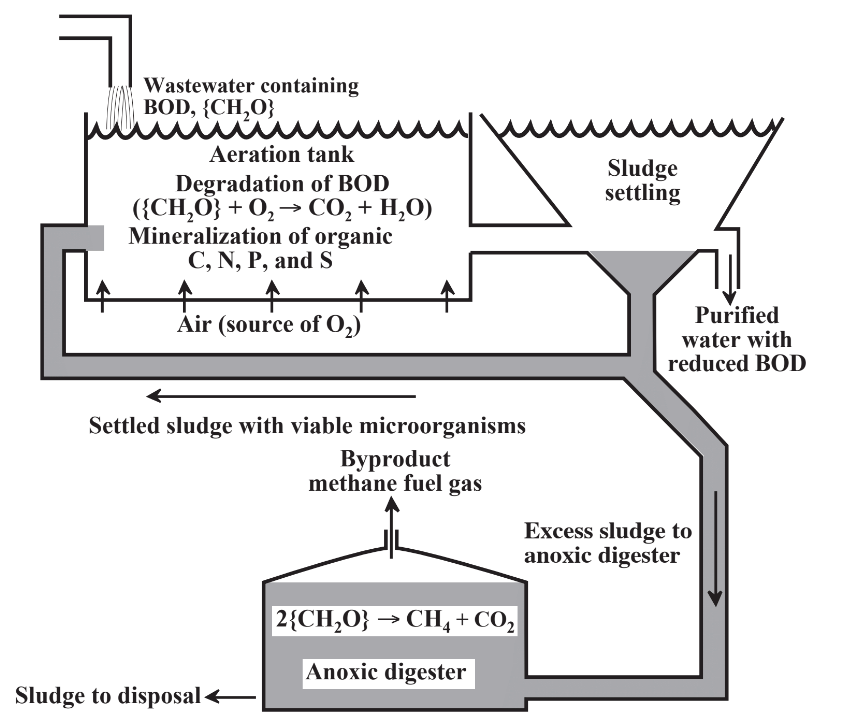9.7: Advanced Wastewater Treatment and Recycling
- Page ID
- 285685
\( \newcommand{\vecs}[1]{\overset { \scriptstyle \rightharpoonup} {\mathbf{#1}} } \)
\( \newcommand{\vecd}[1]{\overset{-\!-\!\rightharpoonup}{\vphantom{a}\smash {#1}}} \)
\( \newcommand{\id}{\mathrm{id}}\) \( \newcommand{\Span}{\mathrm{span}}\)
( \newcommand{\kernel}{\mathrm{null}\,}\) \( \newcommand{\range}{\mathrm{range}\,}\)
\( \newcommand{\RealPart}{\mathrm{Re}}\) \( \newcommand{\ImaginaryPart}{\mathrm{Im}}\)
\( \newcommand{\Argument}{\mathrm{Arg}}\) \( \newcommand{\norm}[1]{\| #1 \|}\)
\( \newcommand{\inner}[2]{\langle #1, #2 \rangle}\)
\( \newcommand{\Span}{\mathrm{span}}\)
\( \newcommand{\id}{\mathrm{id}}\)
\( \newcommand{\Span}{\mathrm{span}}\)
\( \newcommand{\kernel}{\mathrm{null}\,}\)
\( \newcommand{\range}{\mathrm{range}\,}\)
\( \newcommand{\RealPart}{\mathrm{Re}}\)
\( \newcommand{\ImaginaryPart}{\mathrm{Im}}\)
\( \newcommand{\Argument}{\mathrm{Arg}}\)
\( \newcommand{\norm}[1]{\| #1 \|}\)
\( \newcommand{\inner}[2]{\langle #1, #2 \rangle}\)
\( \newcommand{\Span}{\mathrm{span}}\) \( \newcommand{\AA}{\unicode[.8,0]{x212B}}\)
\( \newcommand{\vectorA}[1]{\vec{#1}} % arrow\)
\( \newcommand{\vectorAt}[1]{\vec{\text{#1}}} % arrow\)
\( \newcommand{\vectorB}[1]{\overset { \scriptstyle \rightharpoonup} {\mathbf{#1}} } \)
\( \newcommand{\vectorC}[1]{\textbf{#1}} \)
\( \newcommand{\vectorD}[1]{\overrightarrow{#1}} \)
\( \newcommand{\vectorDt}[1]{\overrightarrow{\text{#1}}} \)
\( \newcommand{\vectE}[1]{\overset{-\!-\!\rightharpoonup}{\vphantom{a}\smash{\mathbf {#1}}}} \)
\( \newcommand{\vecs}[1]{\overset { \scriptstyle \rightharpoonup} {\mathbf{#1}} } \)
\( \newcommand{\vecd}[1]{\overset{-\!-\!\rightharpoonup}{\vphantom{a}\smash {#1}}} \)
\(\newcommand{\avec}{\mathbf a}\) \(\newcommand{\bvec}{\mathbf b}\) \(\newcommand{\cvec}{\mathbf c}\) \(\newcommand{\dvec}{\mathbf d}\) \(\newcommand{\dtil}{\widetilde{\mathbf d}}\) \(\newcommand{\evec}{\mathbf e}\) \(\newcommand{\fvec}{\mathbf f}\) \(\newcommand{\nvec}{\mathbf n}\) \(\newcommand{\pvec}{\mathbf p}\) \(\newcommand{\qvec}{\mathbf q}\) \(\newcommand{\svec}{\mathbf s}\) \(\newcommand{\tvec}{\mathbf t}\) \(\newcommand{\uvec}{\mathbf u}\) \(\newcommand{\vvec}{\mathbf v}\) \(\newcommand{\wvec}{\mathbf w}\) \(\newcommand{\xvec}{\mathbf x}\) \(\newcommand{\yvec}{\mathbf y}\) \(\newcommand{\zvec}{\mathbf z}\) \(\newcommand{\rvec}{\mathbf r}\) \(\newcommand{\mvec}{\mathbf m}\) \(\newcommand{\zerovec}{\mathbf 0}\) \(\newcommand{\onevec}{\mathbf 1}\) \(\newcommand{\real}{\mathbb R}\) \(\newcommand{\twovec}[2]{\left[\begin{array}{r}#1 \\ #2 \end{array}\right]}\) \(\newcommand{\ctwovec}[2]{\left[\begin{array}{c}#1 \\ #2 \end{array}\right]}\) \(\newcommand{\threevec}[3]{\left[\begin{array}{r}#1 \\ #2 \\ #3 \end{array}\right]}\) \(\newcommand{\cthreevec}[3]{\left[\begin{array}{c}#1 \\ #2 \\ #3 \end{array}\right]}\) \(\newcommand{\fourvec}[4]{\left[\begin{array}{r}#1 \\ #2 \\ #3 \\ #4 \end{array}\right]}\) \(\newcommand{\cfourvec}[4]{\left[\begin{array}{c}#1 \\ #2 \\ #3 \\ #4 \end{array}\right]}\) \(\newcommand{\fivevec}[5]{\left[\begin{array}{r}#1 \\ #2 \\ #3 \\ #4 \\ #5 \\ \end{array}\right]}\) \(\newcommand{\cfivevec}[5]{\left[\begin{array}{c}#1 \\ #2 \\ #3 \\ #4 \\ #5 \\ \end{array}\right]}\) \(\newcommand{\mattwo}[4]{\left[\begin{array}{rr}#1 \amp #2 \\ #3 \amp #4 \\ \end{array}\right]}\) \(\newcommand{\laspan}[1]{\text{Span}\{#1\}}\) \(\newcommand{\bcal}{\cal B}\) \(\newcommand{\ccal}{\cal C}\) \(\newcommand{\scal}{\cal S}\) \(\newcommand{\wcal}{\cal W}\) \(\newcommand{\ecal}{\cal E}\) \(\newcommand{\coords}[2]{\left\{#1\right\}_{#2}}\) \(\newcommand{\gray}[1]{\color{gray}{#1}}\) \(\newcommand{\lgray}[1]{\color{lightgray}{#1}}\) \(\newcommand{\rank}{\operatorname{rank}}\) \(\newcommand{\row}{\text{Row}}\) \(\newcommand{\col}{\text{Col}}\) \(\renewcommand{\row}{\text{Row}}\) \(\newcommand{\nul}{\text{Nul}}\) \(\newcommand{\var}{\text{Var}}\) \(\newcommand{\corr}{\text{corr}}\) \(\newcommand{\len}[1]{\left|#1\right|}\) \(\newcommand{\bbar}{\overline{\bvec}}\) \(\newcommand{\bhat}{\widehat{\bvec}}\) \(\newcommand{\bperp}{\bvec^\perp}\) \(\newcommand{\xhat}{\widehat{\xvec}}\) \(\newcommand{\vhat}{\widehat{\vvec}}\) \(\newcommand{\uhat}{\widehat{\uvec}}\) \(\newcommand{\what}{\widehat{\wvec}}\) \(\newcommand{\Sighat}{\widehat{\Sigma}}\) \(\newcommand{\lt}{<}\) \(\newcommand{\gt}{>}\) \(\newcommand{\amp}{&}\) \(\definecolor{fillinmathshade}{gray}{0.9}\)Advanced or tertiary water treatment is applied to the effluent from secondary wastewater treatment facilities. Such treatment is becoming more common in part because water from secondary treatment often contains sufficient BOD to cause problems in receiving waters and contains excessive levels of algal nutrients, especially phosphate, that results in excess algae growth and eutrophication, a condition in which algal biomass accumulates in excess, then decays and depletes water of dissolved oxygen. The other reason for advanced wastewater treatment is that wastewater can be a readily available water source that is potentially easier to bring up to drinking water standards compared to seawater or brackish groundwater. A major barrier to complete water reuse is public opposition to the idea of using water that once was sewage although that is exactly what is done in cases where cities draw their water supplies from rivers downstream from where other cities have discharged treated wastewater.

Most of the water treatment processes discussed so far in this chapter can be used for advanced wastewater treatment. The two major contaminants that need to be removed from such water are organics including BOD and salts including algal nutrient ions containing phosphorus or nitrogen. Also of concern are pathogens including virus and waste pharmaceuticals and their byproducts. Much of the BOD is in the form of residual suspended solids that can be removed by filtration processes. Filtration over beds of sand has long been used to purify water. More recently filtration with membranes that remove extremely small particles has become much more popular. Nanofiltration through membranes with pores 0.1–5 nanometers (nm) in size can even remove viruses from water, a step that is very important for recycling water from sewage sources. Filters with even smaller pores are used for reverse osmosis treatment of water (Figure 9.8) which removes salt ions including algal nutrients with a semipermeable membrane that attracts pure water but rejects ions. Reverse osmosis produces a concentrated brine product that requires disposal.

Figure 9.9 shows a system for reuse of water capable of producing drinking water from sewage. It illustrates the major kinds of treatment processes that can be employed and the applications of the water product. Taking effluent from a secondary sewage treatment plant, this system takes advantage of nature’s inherent ability to purify water by first placing the water in a constructed wetlands. Plants and algae grow profusely in the nutrient-rich wastewater effluent, and their biomass can be harvested for energy production. Water from the wetlands can percolate into underground aquifers or can even be pumped into aquifers where contact with mineral formations further purifies the water. Water leaving the wetlands can be used without additional treatment for irrigation or other non-potable applications, such as cooling water. For household or other uses requiring a higher purity product, the water can be treated with activated carbon to remove organics and subjected to membrane filtration processes to remove small particulate contaminants and some kinds of large-molecule solutes and pathogens, including virus. To remove dissolved salts, reverse osmosis may be employed. Ultraviolet irradiation of the water can be used to destroy pharmaceuticals and their metabolites. The final water product can then be introduced into a municipal water system.
The 275 million liter/day Groundwater Replenishment System of the Orange County Water District in southern California, which cost $481 million and went into operation in late 2007, is the world’s largest water plant designed to produce potable quality water from treated sewage effluent. The water from this system is not currently used for municipal water supply but is pumped into underground aquifers to serve as a future source of drinking water and to prevent infiltration of saline ocean water into the aquifers. The operation of this plant is expected to serve as a model for similar plants around the world.


